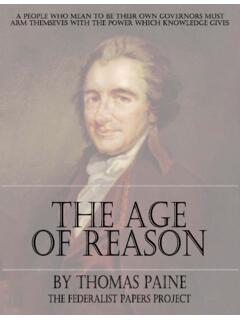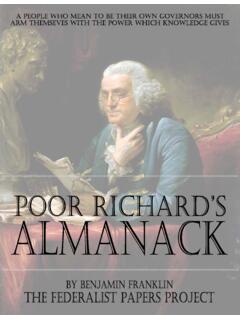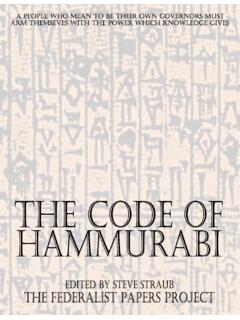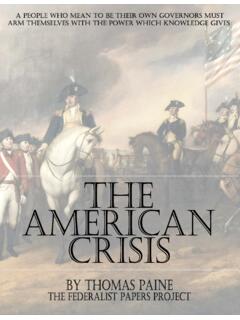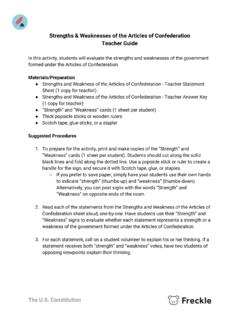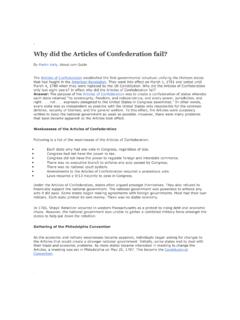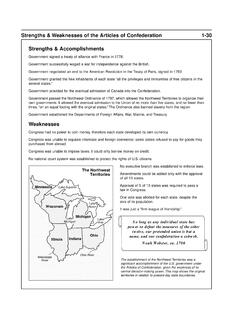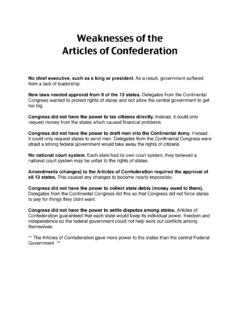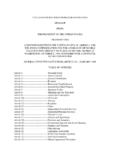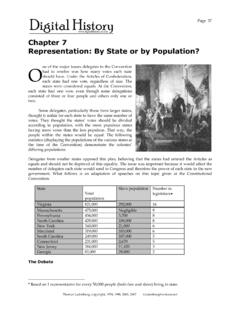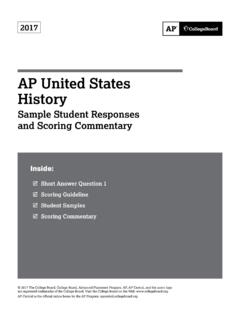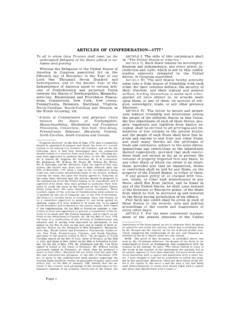Transcription of The Articles of Confederation
1 The Articles of Confederation The Federalist Papers Project The Articles of Confederation Page 2 Table of Contents The Meaning and Definition of the Articles of Confederation : .. 3 Articles of Confederation - Colonies to States .. 3 Articles of Confederation - Why State Constitutions limited the power of Congress .. 3 Articles of Confederation - Establishing the Government .. 4 Government under the Articles of Confederation .. 5 Strengths of the Articles of Confederation .. 5 Weaknesses of the Articles of Confederation .. 6 From the Articles of Confederation to the Constitution .. 7 The Articles of Confederation FULL TEXT .. 8 article I.. 8 article II.. 8 article III.. 8 article IV.. 8 article V.. 8 article VI.. 9 article VII.. 10 article VIII.. 10 article IX.. 10 article X.. 13 article XI.. 13 article XII.. 13 article XIII.. 13 The Articles of Confederation Page 3 The Meaning and Definition of the Articles of Confederation : The Articles of Confederation were the first governing document and the original constitution of the US.
2 The Articles of Confederation contained the terms, agreed by the 13 new states, by which they agreed to participate in a centralized form of government, in addition to their self-rule. Under the Articles of Confederation each of the states retained their sovereignty, freedom and independence. Six drafts of the Articles of Confederation were prepared before they were adopted by Congress on November 15, 1777. The Articles of Confederation became operative on March 1, 1781 when the last of the 13 states finally signed the document. The Articles of Confederation were effective from March 1, 1781 to March 4, 1789 and were the basis of the national government of the US during the American Revolutionary War. The Articles of Confederation were replaced by the US Constitution that went into effect in 1789. Articles of Confederation - Colonies to States Following the Declaration of Independence, the members of the Continental Congress realized that it would be necessary to set up a national government.
3 The 13 Colonies had asked Congress to adopt the Continental army and direct the war. Congress, unexpectedly, became the governing body, and began to act as advisor as the Colonies changed into States. On May 15, 1776 Congress advised all the colonies to form governments for themselves. The Articles of Confederation served as the written document that established the functions of the national government of the United States after it declared independence from Great Britain. Articles of Confederation - Why State Constitutions limited the power of Congress The men who created the State Constitutions took heed from the history of British tyranny whilst adhering to the aspirations of the Declaration of Independence. These led to a number of new ideas and ideals that Americans, across the newly established states, being included in their own, fully documented, State Constitutions. The State Constitutions emphasized the following points: A Separation of powers: State Constitutions separated executive, legislative and judicial powers in order to distribute authority away from the executive branch to preserve individual liberty and prevent and forms of tyranny The Basic rights of the people should be constitutionally protected: Massachusetts, for example, committed part of their constitutions to A Declaration of the Rights of the The Articles of Confederation Page 4 Inhabitants of their state.
4 For the first time the rights of the people were fully documented for all to see and protected accordingly Power comes from the people: The newly formed states had endured the rule of powerful governors and the British monarchy and had no intention of being dominated by another form of executive power. The representatives of the new 13 states agree to create a confederacy called the United States of America, in which each state maintains its own sovereignty and all rights to govern, except those rights specifically granted to Congress. The determination of the new states not to be dominated by another form of executive power - including Congress which had become the National Government - led to many problems and issues due to their limited powers. Articles of Confederation - Establishing the Government The Continental Congress, now the national legislature or government, selected a committee chaired by John Dickinson to write and create the Articles of Confederation but had to be mindful that the newly formed states had already created their individual State Constitutions and had only agreed to participate in a centralized form of government, in addition to their self-rule.
5 The provisos to the establishment of the national government were that: Each state had one vote Each state retained all powers not expressly delegated to Congress Delegates to Congress were to be appointed by state legislatures States would not be deprived of western lands Every state would tax itself to help to contribute to the common expenses of the nation The Articles of Confederation established a "firm league of friendship" between the 13 states. Summary of the Articles of Confederation There was no Chief Executive (President) There was no National Court System There was no National Currency Congress had the powers to establish a Navy and Army Congress had the powers to declare war Congress had the powers to make peace Congress had the powers to sign treaties Congress had the powers to borrow money Congress had the powers to organize a Post Office Congress could not control commerce between states Congress could not enforce treaties Congress could not collect taxes from the States Congress could not draft soldiers The Articles of Confederation were difficult to amend Under the Articles of Confederation it was difficult to pass laws The Articles of Confederation Page 5 Government under the Articles of Confederation The newly formed states feared that a strong central government would create oppression and decrease the power of the people.
6 The representatives of the 13 states agreed to create a confederacy called the United States of America providing each state maintained its own sovereignty and all rights to govern, except those rights specifically granted to Congress. Government under the Articles of Confederation was hampered from the beginning. The problems and issues that faced government under the Articles of Confederation were as follows: There was no one officer to carry out the laws There was no court or judge to settle disputed points of law There was only a very weak legislature Congress consisted of one house, presided over by a president elected each year by the members from among their own number The delegates to Congress could not be more than 7, nor less than 2 from each state, were elected yearly, could not serve for more than 3 years out of 6, and might be recalled at any time by the states that sent them Once assembled on the floor of Congress, the delegates became members of a secret body The doors were shut No spectators were allowed to hear what was said No reports of the debates were taken down All voting was done by states, each casting just 1 vote, no matter how many delegates it had The affirmative votes of 9 states were necessary to pass any important act, or.
7 As it was called, "ordinance." Government under the Articles of Confederation therefore had few powers. Government under the Articles of Confederation could declare war, make peace, issue money, maintain an army and a navy, contract debts, enter into treaties of commerce and settle disputes between states. Government under the Articles of Confederation could not enforce a treaty or a law when made nor impose any taxes for any purpose. Government under the Articles of Confederation was made even more difficult as any important decision had to be approved by 9 of the 13 states delaying some important and critical measures. Strengths of the Articles of Confederation Under the Articles of Confederation it was impossible for Congress to form a strong government but there were some significant achievements. Articles of Confederation Strengths Fact 1: The Articles of Confederation were a written agreement and the first constitution of the United States of America The Articles of Confederation Page 6 Foreign Affairs: The Articles of Confederation gave Congress the power to deal with foreign affairs with the authority to declare war and make peace, alliances and sign treaties: Indian Affairs: The Articles of Confederation gave Congress the power to manage Native Indian affairs Military Affairs: The Articles of Confederation supported the Congressional direction of the Continental Army Interstate Affairs: Government under the Articles of Confederation encouraged coordination and cooperation between different states and Congress settled disputes between states Territorial Government.
8 Government under the Articles of Confederation issued the Ordinance of 1784 and 1785 and the 1987 Northwest Ordinance that provided for the rapid and orderly expansion of the new nation The Articles of Confederation allowed formation of new states that had a population of more than 60,000 Congressional departments: The Department of Treasury, the Department of Postal Service and the Department of Foreign Affairs were established A postal service was established Admiralty courts were established Coin money established Weaknesses of the Articles of Confederation Due to the defects and weaknesses of the Articles of Confederation it was impossible for Congress to form a really strong government There was only one vote per state, regardless of its size There was no power to regulate commerce or trade between the states - each state could put tariffs on trade between states The National Government did not have the independent power to tax.
9 Its revenue would come from the states, each contributing according to the value of privately owned land within its borders The national government could not force the states to obey its laws and notices for taxation were ignored because they could not be enforced There was no national army or navy There was no system of national courts Each state could issue its own paper money Congress lacked strong and solid leadership - there was no President Congress did not have the power to raise money to pay for action against border encroachments by the British and Spanish Any changes to the Articles required a unanimous vote leading to long delays in implementation The Articles of Confederation Page 7 From the Articles of Confederation to the Constitution The defects and weaknesses in the Articles of Confederation made revision necessary. Two conventions were called to consider the state of the country at Annapolis and Philadelphia.
10 The Annapolis convention failed to make any revisions. However, the Philadelphia convention framed the Constitution of the United States. The Constitution was passed to the Continental Congress, which sent it to the legislatures of the states to be accepted or rejected by conventions of the people. When the Constitution was ratified in 1788 Congress fixed a day in 1789 when the First Congress under the Constitution was to assemble. The date of the first presidential election was also fixed. The First Congress under the Constitution duly met on March 4, 1789 and George Washington was elected as the first President of the United States. Washington took the oath of office as the first President of the United States of America on April 30, 1789. To all to whom these Presents shall come, we the undersigned Delegates of the States affixed to our Names send greeting. The Articles of Confederation Page 8 The Articles of Confederation FULL TEXT article I.
